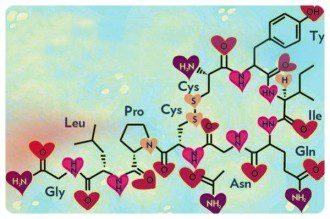Contributing Writer for Wake Up World
The more we understand how nature works, the more we realize just how complex, intricately balanced and ingenious its systems are. One aspect that we are currently gaining more insight into is the human body’s ability to produce natural chemicals and their effects on our general wellbeing.
Oxytocin is a hormone secreted by the posterior lobe of the pituitary gland, a pea-sized structure located at the base of the brain. It is often referred to as a natural love chemical because it is pumped into our bodies when we experience love. It promotes bonding, trust and attachment. It enhances the connection between mother and baby when it is released in high doses during childbirth, and is responsible for the magical seeming way a mother’s breast instantly releases milk at the sight or sound of her infant. It also deepens the sense of union between couples at orgasm.
Oxytocin levels are naturally increased when we feel connected. Actions such as physical touch, cuddling, massage, physical activity, sexual contact, and activities like singing and reading all encourage our bodies to produce oxytocin. When this hormone is whizzing around our bodies it instills a sense of wellbeing and our natural mechanism for healing is promoted.
Conversely levels of this chemical are diminished by isolation or loneliness, anxiety, depression, and chronic stress. When we are deficient in oxytocin, we are likely to have raised levels of the damaging stress hormone cortisol which, as well as negatively affecting our health, adds to the feeling of anxiety, disconnection and despondence.
“Sometimes we spend less quality time with our partner — especially when other demands on us are pressing. However, neuroscience findings suggest that we should change our priorities. By forgoing closeness with our partners, we are also missing our oxytocin boost — making us less agreeable to the world around us and more vulnerable to conflict.” ~ Paul J. Zak
It would seem that nature, in its innate brilliance, actually favors loving supportive social interactions by rewarding them with a natural feel-good, healing elixir. But this raises the question: If we crave oxytocin when our levels (and loving interactions) are low, how might we try to compensate?
Oxytocin and Addiction
A recent article in the international journal Pharmacology, Biochemistry and Behavior explored the current state of research linking oxytocin and addiction. The article, guest edited by Dr. Femke Buisman-Pijlman from the University of Adelaide’s School of Medical Sciences, suggests that addictive behaviour such as drug and alcohol abuse could be associated with low levels of this love hormone.
For a long time it was assumed that addiction was the result of bad life decisions. The fact that as a society we still imprison people for personal drug use suggests that this view is likely still coloring our perception of addiction. However, Buisman-Pijlman’s article puts forward the theory that substances like drugs and alcohol may in fact be a means to compensate for inadequate levels of oxytocin; that when we don’t have the natural feel-good hormone circulating in our bodies, we are more inclined to seek out reward through our external environment.
Addressing the long-held association between addiction and childhood neglect, Dr. Buisman-Pijlman, whose background encompasses both addiction studies and family studies, continues that some individuals’ lack of resistance to addictive substances may be specifically associated with poorly developed oxytocin systems. She believes that when a child feels loved and safe they are more likely to develop a healthy oxytocin system, while harsh conditions (such as neglect and abuse) during early childhood may be responsible for the impaired development of the oxytocin system.
“Previous research has shown that there is a high degree of variability in people’s oxytocin levels. We’re interested in how and why people have such differences in oxytocin, and what we can do about it to have a beneficial impact on people’s health and wellbeing,” she says.
“We know that newborn babies already have levels of oxytocin in their bodies, and this helps to create the all-important bond between a mother and her child. But our oxytocin systems aren’t fully developed when we’re born — they don’t finish developing until the age of three, which means our systems are potentially subject to a range of influences both external and internal,” Dr. Buisman-Pijlman explained. “And because the hardware of the oxytocin system finishes developing in our bodies at around age three, this could be a critical window to study.”
Oxytocin and Parenting
“Oxytocin connects us to other people; oxytocin makes us feel what other people feel. And it’s easy to cause people’s brains to release oxytocin. Let me show you. Come here. Give me a hug.” ~ Paul J. Zak
In the past, the feeling of love was not seen as necessary for successful physical development. The focus of childrearing was on obedience and basic physiological needs like food and housing. Some experts even warned parents that providing too much love and affection could lead to ‘problem children’.
More recently, harsher practices like letting babies ‘cry it out’ and strictly controlled feeding times have declined in popularity as more parents began to choose to listen to their inner knowing, rather than voices of ‘authority’. Today this inclination to respond to our children from a space of love and connection is supported by most experts in the field of child development. Movements like attachment parenting, which encourages feeding on demand and co-sleeping, are becoming increasingly popular. And, now that we understand that there is a physiological motive as well as an emotional one for giving our children lots of love and affection in early childhood, there is even more reason to engage our natural inclinations.
For those who may have lacked the necessary love and attention during the formative stage of the oxytocin producing system, or for those who just want to maximise their feel good experience, the awesome news is that encouraging the body to produce more of this ‘love drug’ is not hard work. All the activities that increase oxytocin production are pleasurable and easily accessible. Activities like sex, cuddling, hugging, all raise levels naturally. Pleasurable activities like long baths, eating chocolate, listening to soothing music, singing in the shower, and showing our pets affection are also recognized as effective ways to increase the amount of oxytocin circulating in the body.
References:
- www.ncbi.nlm.nih.gov/pmc/articles/PMC3319675/
- www.eurekalert.org/pub_releases/2014-03/uoa-ch032014.php
- www.ccare.stanford.edu/wp-content/uploads/2013/09/Oxytocin-Pathways-and-the-Evolution-of-Human-Behavior.pdf
- www.psychologytoday.com/blog/the-moral-molecule/201311/the-top-10-ways-boost-good-feelings
About the author:
Christina Lavers is a writer, an artist, a creative enthusiast, and an inner world explorer. Born in Montreal Quebec, Canada, she now lives with her life partner and son in a rainforest pocket in the hills behind Coffs Harbour, NSW Australia. She spends her time playing, creating, growing and sharing.
Christina is devoted to assisting people to find and connect with their own creative magical current that flows deep within. She is now offering a comprehensive e-course designed to help people light up their world with passion and creativity. You can access Section One here for free!
Christina has also recently published her first full length book, a memoir about her wild awakening journey entitled Jump Into the Blue, and she is currently working on the next one.
“My journey has been about personal alchemy… exploring the mysteries of my soul and my environment, and learning to bring all aspects, the light and the dark, together with the transcending ingredient… love. The more I uncover and nurture the wounded aspects of my being, the more whole and grounded I feel and the more my outer world reflects the love, wonder and magic I have discovered inside”.
You can follow Christina’s work at:
Further reading from Christina Lavers:
- Are You a Bridge Between Two Worlds?
- 10 Signs You’ve Bought Spin
- New Study Shows Regular Contact with Nature Reduces Crime, Increases Social Cohesion
- Research Shows Just 7 Minutes of Meditation Can Reduce Racial Prejudice
- Taking Care of Our Inner Tribes – Microflora, Awakening and You
- Groundbreaking Study Maps the Decline of Wild Bee Communities in the United States
- Taking Responsibility For Our Energy
- More Evidence That TV is Dumbing Us Down
- Synchrony and Exertion of Dancing Found to Encourage Social Bonding, Raise Pain Threshold
- Quitting Smoking? Try These Herbs, Tips and Incentives to Help You Succeed!

If you've ever found value in our articles, we'd greatly appreciate your support by purchasing Mindful Meditation Techniques for Kids - A Practical Guide for Adults to Empower Kids with the Gift of Inner Peace and Resilience for Life.
In the spirit of mindfulness, we encourage you to choose the paperback version. Delve into its pages away from screen glare and notifications, allowing yourself to fully immerse in the transformative practices within. The physical book enriches the learning process and serves as a tangible commitment to mindfulness, easily shared among family and friends.
Over the past few years, Wake Up World has faced significant online censorship, impacting our financial ability to stay online. Instead of soliciting donations, we're exploring win-win solutions with our readers to remain financially viable. Moving into book publishing, we hope to secure ongoing funds to continue our mission. With over 8,500 articles published in the past 13 years, we are committed to keeping our content free and accessible to everyone, without resorting to a paywall.










